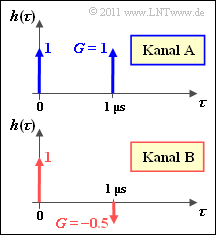Aufgabe 2.8: COST-Verzögerungsmodelle
Aus LNTwww
Version vom 20. November 2017, 23:24 Uhr von Hussain (Diskussion | Beiträge)
Rechts sind vier Verzögerungs–Leistungsdichtespektren als Funktion der Verzögerungszeit $\tau$ logarithmisch aufgetragen:
- $$10 \cdot {\rm lg}\hspace{0.15cm} ({{\it \Phi}_{\rm V}(\tau)}/{\it \Phi}_{\rm 0}) \hspace{0.05cm},$$
Hierbei ist als Abkürzung $\phi_0 = \phi_{\rm V}(\tau = 0)$ verwendet.
Es handelt sich um die sog. COST–Verzögerungsmodelle. Die obere Skizze beinhaltet die beiden Profile RA (Rural Area) und TU (Typical Urban). Für diese gilt folgender Verlauf:
- $${{\it \Phi}_{\rm V}(\tau)}/{\it \Phi}_{\rm 0} = {\rm exp}[ -\tau / \tau_0] \hspace{0.05cm}.$$
Der Wert des Parameters $\tau_0$ (Zeitkonstante der AKF) soll in der Teilaufgabe (1) aus der Grafik ermittelt werden. Beachten Sie hierzu die angegebenen $\tau$–Werte für $–30 \ \rm dB$:
- $${\rm RA:}\hspace{0.15cm}\tau_{-30} = 0.75\,{\rm \mu s} \hspace{0.05cm},\hspace{0.2cm} {\rm TU:}\hspace{0.15cm}\tau_{-30} = 6.9\,{\rm \mu s} \hspace{0.05cm}. $$
Die untere Grafik gilt für ungünstigere Verhältnisse in
- städtischen Gebieten (Bad Urban, BU):
- $${{\it \Phi}_{\rm V}(\tau)}/{{\it \Phi}_{\rm 0}} = \left\{ \begin{array}{c} {\rm exp}[ -\tau / \tau_0]\\ 0.5 \cdot {\rm exp}[ (5\,{\rm \mu s}-\tau) / \tau_0] \end{array} \right.\quad \begin{array}{*{1}c} \hspace{-0.55cm} {\rm Bereich}\hspace{0.15cm}0 < \tau < 5\,{\rm \mu s}\hspace{0.05cm},\hspace{0.15cm}\tau_0 = 1\,{\rm \mu s} \hspace{0.05cm}, \\ \hspace{-0.15cm} {\,\, \,\, \rm Bereich}\hspace{0.15cm}5\,{\rm \mu s} < \tau < 10\,{\rm \mu s}\hspace{0.05cm},\hspace{0.15cm}\tau_0 = 1\,{\rm \mu s} \hspace{0.05cm}, \end{array}$$
- in ländlichen Gebieten (Hilly Terrain, HT):
- $${{\it \Phi}_{\rm V}(\tau)}/{{\it \Phi}_{\rm 0}} = \left\{ \begin{array}{c} {\rm exp}[ -\tau / \tau_0]\\ {0.04 \cdot \rm exp}[ (15\,{\rm \mu s}-\tau) / \tau_0] \end{array} \right.\quad \begin{array}{*{1}c} \hspace{-0.55cm} {\rm Bereich}\hspace{0.15cm}0 < \tau < 2\,{\rm \mu s}\hspace{0.05cm},\hspace{0.15cm}\tau_0 = 0.286\,{\rm \mu s} \hspace{0.05cm}, \\ \hspace{-0.35cm} {\rm Bereich}\hspace{0.15cm}15\,{\rm \mu s} < \tau < 20\,{\rm \mu s}\hspace{0.05cm},\hspace{0.15cm}\tau_0 = 1\,{\rm \mu s} \hspace{0.05cm}. \end{array}$$
Für die Modelle RA, TU und BU sollen folgende Kenngrößen ermittelt werden:
- Die Mehrwegeverbreiterung $T_{\rm V}$ ist die Standardabweichung der Verzögerungszeit $\tau$. Hat das Verzögerungs–LDS ${\it \Phi}_{\rm V}(\tau)$ einen exponentiellen Verlauf wie bei den Profilen „RA” und „TU”, so gilt $T_{\rm V} = \tau_0$, siehe Aufgabe A2.7.
- Die Kohärenzbandbreite $B_{\rm K}$ ist der $\Delta f$–Wert, bei dem die Frequenzkorrelationsfunktion $\varphi_{\rm F}(\Delta f)$ betragsmäßig erstmals auf die Hälfte abgefallen ist. Bei exponentiellem ${\it \Phi}_{\rm V}(\tau)$ wie bei „RA” und „TU” ist das Produkt $T_{\rm V} \cdot B_{\rm K} \approx 0.276$, siehe Aufgabe A2.7.
Hinweis:
- Die Aufgabe gehört zum Kapitel Das GWSSUS–Kanalmodell.
- Vorgegeben sind die folgenden Integrale:
- $$\frac{1}{\tau_0} \cdot \int_{0}^{\infty}\hspace{-0.15cm} {\rm e}^{ -\tau / \tau_0} \hspace{0.15cm}{\rm d} \tau = 1 \hspace{0.05cm},\hspace{0.6cm} \frac{1}{\tau_0} \cdot \int_{0}^{\infty}\hspace{-0.15cm} {\tau} \cdot{\rm e}^{ -\tau / \tau_0}\hspace{0.15cm}{\rm d} \tau = \tau_0 \hspace{0.05cm},\hspace{0.6cm} \frac{1}{\tau_0} \cdot \int_{0}^{\infty} \hspace{-0.15cm}{\tau^2} \cdot{\rm e}^{ -\tau / \tau_0}\hspace{0.15cm}{\rm d} \tau = 2\tau_0^2\hspace{0.05cm}.$$
Fragebogen
Musterlösung
(1)
(2)
(3)
(4)
(5)
